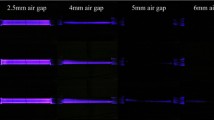Abstract
For low power dielectric barrier discharge (DBD) used in small-size material treatment or portable devices, high-step transformer parasitic capacitance greatly influences the performance of the resonant converter as it is of the same order of magnitude as the equivalent capacitance of DBD load. In this paper, steady-state analysis of the low power DBD is presented, considering the inevitable parasitic capacitance of the high-step transformer. The rectifier-compensated first harmonic approximation (RCFHA) is applied to linearize the equivalent load circuit of DBD at low frequency and the derived expressions are accurate and convenient for the analysis and design of the power supply. Based on the proposed linear equivalent load circuit, the influence of transformer parasitic capacitance on the key parameters, including the frequency range and the applied electrode voltage, is discussed when the power is regulated with pulse frequency modulation (PFM). Also, a design procedure is presented based on the derived expressions. A prototype is constructed according to the design results and the accuracy of the design is verified by experimental results.
Similar content being viewed by others
References
Alonso, J.M., Valdés, M., Calleja, A.J., et al., 2003. High frequency testing and modeling of silent discharge ozone generators. Ozone Sci. Eng., 25(5):363–376. [doi:10.1080/01919510390481685]
Bonaldo, J.P., Pomilio, J.A., 2010. Control strategies for high frequency voltage source converter for ozone generation. Proc. IEEE Int. Symp. on Industrial Electronics, p.754–760. [doi:10.1109/ISIE.2010.5637402]
Burany, N., Huber, L., Pejovic, P., 2008. Corona discharge surface treater without high voltage transformer. IEEE Trans. Power Electron., 23(2):993–1002. [doi:10.1109/TPEL.2007.915760]
Doebbelin, R., Benecke, M., Lindemann, A., 2008. Calculation of leakage inductance of core-type transformers for power electronic circuits. Proc. 13th Power Electronics and Motion Control Conf., p.1280–1286. [doi:10.1109/EPEPEMC.2008.4635445]
Fang, Z., Qiu, X., Qiu, Y., et al., 2006. Dielectric barrier discharge in atmospheric air for glass-surface treatment to enhance hydrophobicity. IEEE Trans. Plasma Sci., 34(4):1216–1222. [doi:10.1109/TPS.2006.877619]
Fu, D., Lee, F.C., Qiu, Y., et al., 2008. A novel high-power-density three-level LCC resonant converter with constant-power-factor-control for charging applications. IEEE Trans. Power Electron., 23(5):2411–2420. [doi:10.1109/TPEL.2008.2002052]
Gibalov, V.I., Pietsch, G.J., 2000. The development of dielectric barrier discharges in gas gaps and on surfaces. J. Phys. D Appl. Phys., 33(20):2618–2636. [doi:10.1088/0022-3727/33/20/315]
Gilbert, A.J., Bingham, C.M., Stone, D.A., et al., 2007. Normalized analysis and design of LCC resonant converters. IEEE Trans. Power Electron., 22(6):2386–2402. [doi:10.1109/TPEL.2007.909243]
Gilbert, A.J., Bingham, C.M., Stone, D.A., et al., 2008. Self-oscillating control methods for the LCC current-output resonant converter. IEEE Trans. Power Electron., 23(4):1973–1986. [doi:10.1109/TPEL.2008.925198]
Jidenko, N., Petit, M., Borra, J.P., 2006. Electrical characterization of micro-discharges produced by dielectric barrier discharge in dry air at atmospheric pressure. J. Phys. D Appl. Phys., 39(2):281–293. [doi:10.1088/0022-3727/39/2/008]
Kinnares, V., Hothongkham, P., 2010. Circuit analysis and modeling of a phase-shifted pulse-width modulation full-bridge-inverter-fed ozone generator with constant applied electrode voltage. IEEE Trans. Power Electron., 25(7):1739–1752. [doi:10.1109/TPEL.2010.2042075]
Kostov, K.G., Nishime, T.M.C., Hein, L.R.O., et al., 2013. Study of polypropylene surface modification by air dielectric barrier discharge operated at two different frequencies. Surf. Coat. Technol., 234:60–66. [doi:10.1016/j.surfcoat.2012.09.041]
Liu, Y., He, X., 2005. PDM and PFM hybrid control of a series-resonant inverter for corona surface treatment. IEE Proc.-Electr. Power Appl., 152(6):1445–1450. [doi:10.1049/ip-epa:20045270]
Martin-Ramos, J.A., Pernia, A.M., Diaz, J., et al., 2008. Power supply for a high-voltage application. IEEE Trans. Power Electron., 23(4):1608–1619. [doi:10.1109/TPEL.2008.925153]
Shafiei, N., Pahlevaninezhad, M., Farzanehfard, H., et al., 2011. Analysis and implementation of a fixed-frequency LCLC resonant converter with capacitive output filter. IEEE Trans. Ind. Electron., 58(10):4773–4782. [doi:10.1109/TIE.2011.2116758]
Shafiei, N., Pahlevaninezhad, M., Farzanehfard, H., et al., 2013. Analysis of a fifth-order resonant converter for high-voltage DC power supplies. IEEE Trans. Power Electron., 28(1):85–100. [doi:10.1109/TPEL.2012.2200301]
Wagner, H.E., Brandenburg, R., Kozlov, K.V., et al., 2003. The barrier discharge: basic properties and applications to surface treatment. Vacuum, 71(3):417–436. [doi:10.1016/S0042-207X(02)00765-0]
Wang, C., He, X., 2006. Preparation of hydrophobic coating on glass surface by dielectric barrier discharge using a 16 kHz power supply. Appl. Surf. Sci., 252(23):8348–8351. [doi:10.1016/j.apsusc.2005.11.042]
Wang, H., Fang, Z., Qiu, Y., et al., 2005. On the changing of equivalent capacitance in dielectric barrier discharge. Insul. Mater., 38(1):37–40. [doi:10.3969/j.issn.1009-9239.2005. 01.012] (in Chinese).
Wedaa, H., Abdel-Salam, M., Ahmed, A., et al., 2011. NO removal using dielectric barrier discharges in a multirod reactor stressed by AC and pulsed high voltages. IEEE Trans. Dielectr. Electr. Insul., 18(5):1743–1751. [doi:10.1109/TDEI.2011.6032846]
Williamson, J.M., Trump, D.D., Bletzinger, P., et al., 2006. Comparison of high-voltage ac and pulsed operation of a surface dielectric barrier discharge. J. Phys. D Appl. Phys., 39(20):4400–4406. [doi:10.1088/0022-3727/39/20/016]
Youssef, M.Z., Jain, P.K., 2007. Series-parallel resonant converter in self-sustained oscillation mode with the high-frequency transformer-leakage-inductance effect: analysis, modeling, and design. IEEE Trans. Ind. Electron., 54(3):1329–1341. [doi:10.1109/TIE.2007.892742]
Author information
Authors and Affiliations
Corresponding author
Additional information
Project supported by the National Natural Science Foundation of China (No. 51107115) and the China Postdoctoral Science Foundation (No. 20110491766)
ORCID: Tang-tang GUO, http://orcid.org/0000-0002-9603-0997
Rights and permissions
About this article
Cite this article
Guo, Tt., Liu, Xl., Hao, Sq. et al. Analysis and design of pulse frequency modulation dielectric barrier discharge for low power applications. Frontiers Inf Technol Electronic Eng 16, 249–258 (2015). https://doi.org/10.1631/FITEE.1400185
Received:
Accepted:
Published:
Issue Date:
DOI: https://doi.org/10.1631/FITEE.1400185
Key words
- Dielectric barrier discharge
- Rectifier-compensated first harmonic approximation
- Parasitic capacitance
- Power converter design




